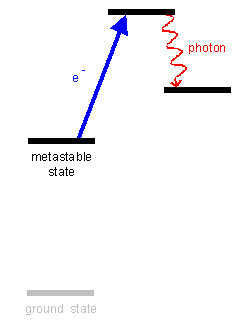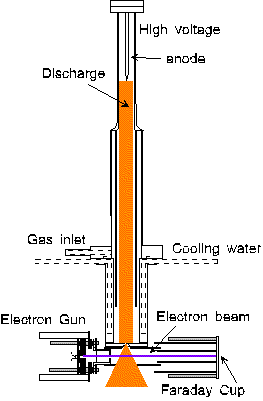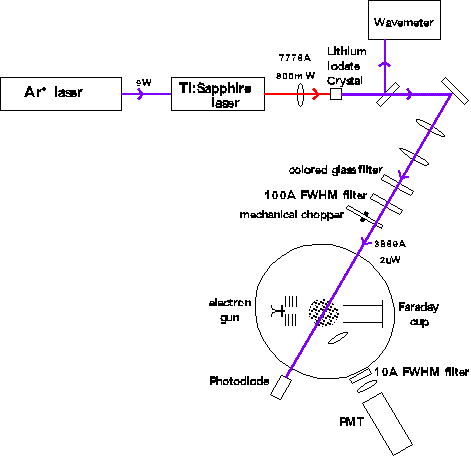Excitation out of Metastable States
Hollow Cathode Metastable Source

What are Metastable States?
Atoms can be excited (by lasers, electron collisions, etc.) to energy levels above their ground states. Normally, these levels are short-lived and the atoms quickly decay (in 10-7 sec or less) back to the ground state. When the atom is excited into a level which is not allowed to quickly decay (i.e., it survives 10-6 sec or longer) it is said to exist in a metastable level. These metastable atoms contain a lot of energy and are very important in real-world applications such as gas-discharge lasers and plasma processing of semiconductors. In our lab we measure cross sections for electron-impact excitation out of the metastable levels into higher excited levels.How are Metastable Atoms created?
The study of electron-metastable atom collisions is complicated by the difficulty of producing targets of metastable atoms in the lab. This experiment uses a hollow cathode discharge to produce an atomic beam of metastable atoms. The beam emerging from the hollow cathode discharge has a metastable atom density of approximately 107 atoms/cm3.
How do we measure the signal?
In this experiment, a low-energy electron beam crosses the atomic beam at a right angle. The metastables are excited into higher levels, and when these levels decay, they emit visible radiation. This emitted radiation is measured using a photomultiplier tube and from this information we can extract cross sections.
Absolute calibration of cross sections:
We get to use really neat lasers (Ar+ and Ti:Sapphire, along with some frequency doubling) to obtain absolute values for our cross sections. We use a laser-induced fluorescence(LIF) technique, which involves taking the ratio of our electron-excitation signal to a laser-excitation signal.Some experimental specs:
| Target Density: | 107 to 108 metastables/cm3 |
| Energy Range: | 0eV to ground state onset |
| Electron Beam current: | 10 µA at 10 eV |
| Atoms studied: | He(21S) and He(23S) metastables (excitation into more than 25 higher levels studied) Ar( 1s3 ) and Ar( 1s5 ) metastables (excitation into 8 higher levels studied) Ne( 1s3 ) and Ne( 1s5 ) metastables (excitation into 10 higher levels studied) Kr( 1s3 ) and Kr( 1s5 ) metastables (excitation into 7 higher levels studied) |
Recent Published Results
- Measurement of electron-impact excitation cross sections out of the neon 3P2 metastable level
-
John B. Boffard, M. L. Keeler, Garrett A. Piech, L. W. Anderson, and Chun C. Lin,
Phys Rev. A 64 (2001) 032708.
- Measurement of Cross Sections for Electron Excitation out of the Metastable Levels of Argon
-
Garrett A. Piech, John B. Boffard, Mark F. Gehrke, L. W. Anderson, and Chun C. Lin,
Phys Rev. Lett. 81 (1998) 309-312.
- Electron excitation out of the 23S metastable level of helium into high-n triplet levels
-
Garrett A Piech, J Ethan Chilton, L W Anderson, and Chun C Lin,
J. Phys. B: At. Mol. Opt. Phys. 31 (1998) 859-872.
- Cross sections for electron excitation of the 23S metastable level of He into higher triplet levels
-
Garrett A. Piech, Mark E. Lagus, L. W. Anderson, Chun C. Lin, and M. R. Flannery,
Physical Review A 55 (1997) 2842-2856.
- A method for measuring cross sections for electron-impact excitation out of metastable levels of atoms
-
Ronald B. Lockwood, L. W. Anderson, and Chun C. Lin,
Z. Phys. D- Atoms, Molecules and Clusters 24 (1992) 155-160.
- Cross sections for electron excitation out of the metastable levels of helium into the higher singlet levels
-
Ronald B. Lockwood, Francis A. Sharpton, L. W. Anderson, and Chun C. Lin,
Physics Letters A 166 (1992) 357-360.
back to experiments list... back to home page